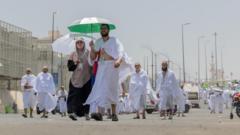As over 1.4 million Muslims embark on this year's Hajj pilgrimage in Mecca, Saudi Arabia, the government is taking rigorous measures to ensure the safety of the pilgrims in the face of intense heat. Following last year's incidents, where 1,300 individuals, mainly unregistered pilgrims, succumbed to extreme temperatures, Saudi authorities are committed to preventing similar tragedies.
To combat temperatures expected to rise as high as 44C (111F), the Saudi government has increased safety protocols. Thousands of trees have been planted and over 400 cooling units installed throughout the city. The government has also imposed strict regulations, banning children under 12 and threatening fines for individuals attempting to perform Hajj without an official permit—a consequence that can include penalties up to $5,000 and a ten-year entry ban.
Officials have reported that they thwarted over 269,000 unauthorized entries to Mecca, highlighted by the fact that many of last year's fatalities involved unregistered pilgrims who lacked access to essential accommodations and cooling facilities. Often, these individuals seek cheaper entry through tourist or visitor visas, bypassing the costly official Hajj packages that range from $4,000 to $20,000 based on numerous factors.
Hajj is one of the five pillars of Islam, obligatory for all capable adult Muslims once in their lifetime. The journey includes essential rituals, such as circling the Kaaba—a pilgrimage started under strict clothing guidelines symbolizing purity and devotion. After visiting the Grand Mosque, pilgrims proceed to Mina before heading to Mount Arafat, where the Prophet Muhammad delivered his final sermon.
To mitigate the impact of heat, the Saudi health ministry has urged pilgrims to follow several guidelines, including avoiding direct sunlight during peak hours and regularly hydrating. Shaded areas have been expanded by approximately 50,000 square meters and advanced cooling technologies have been implemented, positioning Mecca's Grand Mosque as having the largest cooling system in the world. Additional infrastructure improvements, including rubberized roads aimed at reducing surface temperatures, have also been prioritized, alongside the utilization of artificial intelligence to manage crowds effectively.
Past tragedies, including a 2015 stampede that led to over 2,300 deaths, and the recent heat deaths, emphasize the critical importance of these enhanced safety measures, as pilgrims engage in a journey steeped in spiritual significance amidst challenging conditions.





















